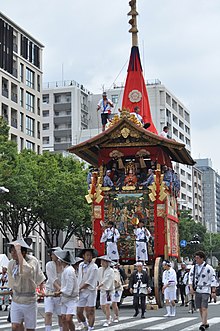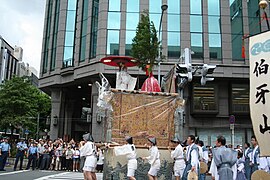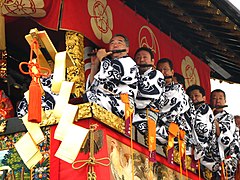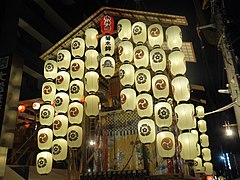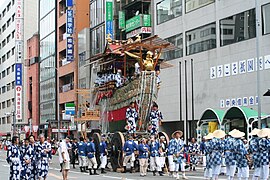Gion-Matsuri
The Gion-Matsuri ( Japanese 祇 園 祭 ) is celebrated annually from July 1st to 31st in Kyoto . The festival is known for the parade of tall, artistically designed floats and large portable shrines.
The party
The Gion-Matsuri is one of the "Three Great Matsuri of Japan" and is the largest and most entertaining of these. It takes place throughout July, as do the celebrations at Yasaka Shrine .
The highlights take place on July 17th (First Festival Day - 前 祭 (Mae Matsuri)) and a week later on July 24 (Second Festival Day - 後 祭 (Ato Matsuri)). On July 17th you can admire 9 floats and 14 portable shrines, on July 24th a float and 9 shrines, three of which are float-sized. The whole city is then in a festive mood. Houses along the processional route are usually open to the general public, who can then admire display screens (屏風, Byōbu) and other treasures that have been passed down through the generations. The festival is therefore also called "Byōbu Festival".
The origin: When Kyoto was the capital of Japan, the whole country was ravaged by an epidemic in 869. The emperor then sent a messenger to the Yasaka shrine to pray that the plague would soon end. The shrine was also ordered to set up 66 lances to represent the 66 provinces. It was believed that the brother of the sun goddess Amaterasu found his last rest in the Gion Shrine, the old name for the Yasaka Shrine, and that his spirit has passed over to the sacred chariots of the shrine. Dedicated with this spirit, it was assumed that these wagons could also fight the plague. They were therefore drawn to the center of the city by young men, and the plague actually disappeared. The residents of Kyoto decided in 970 to hold this float parade annually. However, Kyōto suffered from a civil war in the 16th century, so that the festival could not be held at that time.
In the peaceful years of the Tokugawa period , the wagons were made larger and very decorative. Influences from China, Persia, ancient Korea, and even from the Netherlands and France were incorporated into the design.
procedure
The Gion-Matsuri lasts the whole of July, with larger and smaller performances alternating. The most important are:
- July 2: Kujitori-shiki (久 慈 取 式). On the day the order of the cars is determined by lots.
- July 10th, evening: Omukae Chōchin (お 迎 え 提 灯). The shrines are greeted with lanterns hanging from tall poles.
- July 10: Mikoshi-Arai (神 輿 洗). The main car of the Yasaka Shrine is brought undecorated to the Kamogawa River and cleaned.
- July 14-16: Mae Matsuri Yoiyama (前 祭 宵 山). The floats from the First Parade can be viewed; they are illuminated in the evening.
- July 17, 9 a.m .: Mae Matsuri Yamahoko Junkō (前 祭 山 鉾 巡行). The 23 floats and shrines of the First Parade are pulled through the streets of Shijō, Kawaramachi and Oike under sunlight.
- July 17, 4 p.m .: Shinko-sai (神 幸 祭). Three holy shrines are carried through the city on their shoulders by selected men.
- July 21-23: Ato Matsuri Yoiyama (後 祭 宵 山). The 9 shrines and the float from the second parade can be visited.
- July 24th, 9:30 a.m .: Ato matsuri Yamahoko Junkō (山 鉾 巡行). The shrines and float of the Second Parade are carried and pulled through the streets of Shijō, Kawaramachi and Oike.
- July 24th: Hanagasa-Junkō (花 笠 巡行). Moving the flower wagon.
- July 28th: Mikoshi-Arai (神 輿 洗). Ritual washing of the portable shrines.
photos
Floats and portable shrines
Floats (鉾·曳山, Hoko - Hikiyama)
- Weight: about 12 tons
- Height: 25 m to the top, 8 m to the roof of the vehicle
- Wheels: about 1.9 m in diameter
- Roof: approximately 4.5 m long and 3.5 m wide
- Cabin (鉾 胴, Hokodō): 3.5 m long, 3 m wide
- Base (石 持, Ishimochi): 6 m long
- Musician gallery (囃 子 舞台, Hayashi Butai): 6 to 10 square meters
- Zieher (曳 手, Hikite): 40 to 50 people
- Car driver (音 頭 取, ondo-tori): 2 to 4 people
- Attendant on the roof (屋 根 方, Yanegata): 4 people
Portable shrines (舁 山, Kakiyama)
- Weight: 1.2 to 1.6 tons
- Porters: 14 to 24 people
Unlike the usual Kakiyama, the Iwato-yama (岩 戸 山), the Kita Kannon-yama (北 観 音 山) and the Minami Kannon-yama (南 観 音 山) have the same structure as the floats. They are therefore pulled instead of carried.
The participating floats and shrines
First move
- Naginata Hoko (長刀 鉾)
- Kanko Hoko (函谷 鉾)
- Kikusui Hoko (菊 水 鉾)
- Tsuki Hoko (月 鉾)
- Niwatori Hoko (鶏 鉾)
- Iwato Yama (岩 戸 山)
- Fune Hoko (船 鉾)
- Yamabushi Yama (山 伏 山)
- Mōsō Yama (孟 宗 山)
- Taishi Yama (太子 山)
- Kakkyo Yama (郭 巨 山)
- Hoshō Yama (保 昌 山)
- Aburatenjin Yama (油 天神 山)
- Shijōkasa Hoko (四条 笠 鉾)
- Tōrō Yama (蟷 螂 山)
- Hakuga Yama (伯牙 山)
- Tokusa Yama (木 賊 山)
- Araretenjin Yama (霰 天神 山)
- Hakurakuten Yama (白 楽 天山)
- Ashikari Yama (蘆 刈 山)
- Urade Yama (占 出山)
- Ayagasa Hoko (綾 笠 鉾)
Second move
- Kitakannon Yama (北 観 音 山)
- Minamikannon Yama (南 観 音 山)
- Hashibenkei Yama (橋 弁 慶 鉾)
- Ennogyoja Yama (役 行者 山)
- Koi Yama (鯉 山)
- Hachiman Yama (八 幡 山)
- Suzuka Yama (鈴鹿 山)
- Kuronushi Yama (黒 主 山)
- Jōmyō Yama (浄 妙 山)
- Ōfune Hoko (大船 鉾)
Remarks
- ↑ The other two are the Kanda-Matsuri in Tōkyō and the Tenjin-Matsuri in Osaka.
literature
- Kyoto City Tourism Assn. (Ed.): GION MATSURI FESTIVAL: Japanese / English
